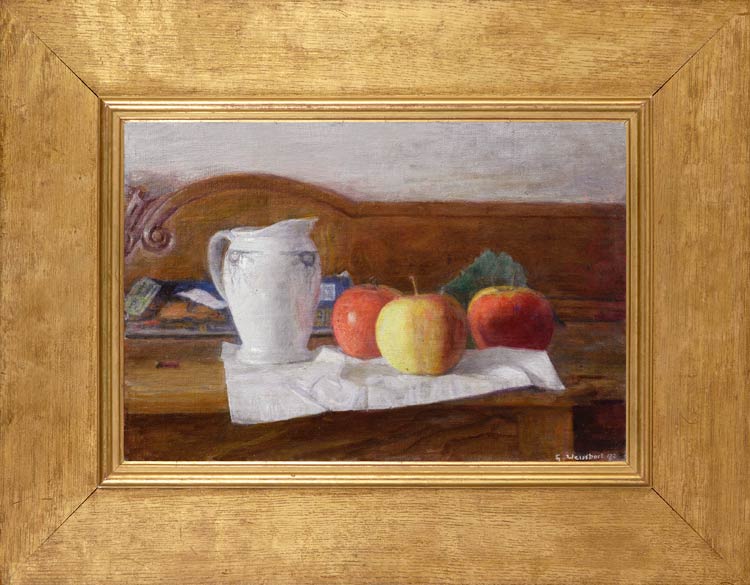Here Weissbort employs a brilliant island of colour within a tonal, earthy setting which acts as a frame-within-a-frame, providing a foil to the clear reds/yellows of the apples, and to the glossy sheen of the white jug. This is a work which picks out texture as well as colour; so that, whilst the wood and plaster is undifferentiated, retreating into the diffused tones of the background, the still life vignette is alive with the sensual surfaces of rough linen, hard glazed ceramic, and waxy apple. The artist is painting as the eye sees – highlighting everything within an oval focus, and letting the rest stand back. A tranquil, sunny vision of autumn, where the artist once more has Cézanne at the back of his mind and remakes the arrangement and textures of his drapery, ceramics, wood and fruit (see, for example, Cézanne’s Still life with kettle, Musée d’Orsay).
Biographical details
George Weissbort (1928-2013) was born in Belgium and moved to London at the age of 7. He attended the Central School of Art & Design (now St Martin’s) where he was taught by Ruskin Spear and Rodrigo Moynihan. He was influenced by Arthur Segal to move from the abstract expressionism of the 1940s to realism, and by Bernard Meninsky, who taught life drawing at the Central School, to study the Old Masters. He turned first to artists such as Cézanne and Matisse, and later to Vermeer, Chardin, Velasquez, Corot, Titian, Holbein, and Piero della Francesca, amongst others.
He exhibited regularly at the Royal Academy, the Royal Society of Portrait Painters and the Fine Art Society. In 1964-65 he had a large exhibition in Paris, and in 2006 he had a one-man retrospective at the Chambers Gallery, London, followed in 2008 by another at the Denise Yapp Gallery, Whitebrook, Monmouth.
He wrote essays on art and criticism which look both at the techniques of making a painting, and of appreciating a work of art. The latter skill he believed came only after years of consciously training the eye to see as the artist saw, considering for example the ‘negative’ spaces around and between objects. He also discussed the work of specific artists, such as Lucien Freud and Vermeer.
His obituary in The Independent quotes Brian Sewell, a friend, as saying of him that Weissbort ‘painted the right pictures at the wrong time’. His appeal was to those who understood his models and influences; he could be described as a painter’s painter, and the same obituary quotes Paula Rego describing him as ‘a truly honest artist who knows so much about painting’.
Publications: George Weissbort, Paintings and Drawings (Parnassus, 2008), ill. 130 colour plates; includes transcripts of a filmed interview; essays by Tony Rudolph, David Lee and Bernard Dunstan RA.
YouTube video: A tribute to George Weissbort by John French.


